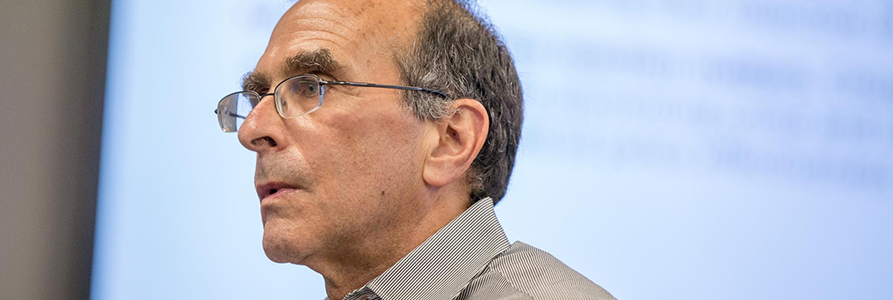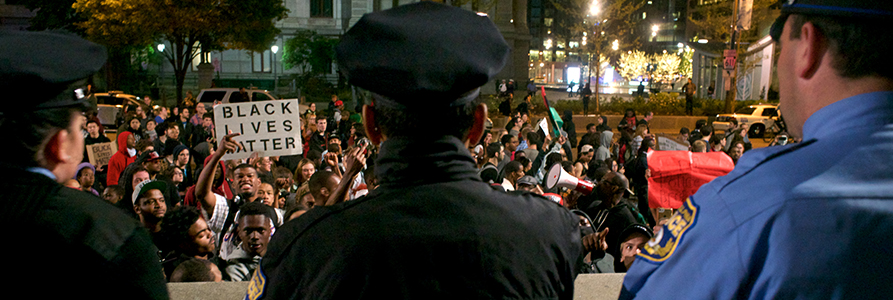Police, Violence, and Data: The Black Lives Matter Movement
By Michael Cunningham
A conversation about the Black Lives Matter Movement, and the legacy that sparked it, with one of the world's leading experts on policing
Professor Daniel Nagin is the 2014 recipient of the prestigious Stockholm Prize on Criminology, an elected fellow of the American Society of Criminology, and the Teresa and H. John Heinz III University Professor of Public Policy and Statistics. His research focuses on the evolution of criminal and antisocial behaviors over the life course the deterrent effect of criminal and non-criminal penalties on illegal behaviors, and the development of statistical methods for analyzing longitudinal data.
In the wake of recent incidences of lethal violence involving law enforcement officials in Baton Rouge, Falcon Heights, and Dallas, we sat down with Nagin to talk to him about what factors led to these events, why there is apparent mistrust between citizens and law enforcement officials, and what policy, research, and training measures can be taken to help prevent these situations in the future.

Professor Daniel Nagin
---
Michael Cunningham: Based on your research, are the events in recent years and weeks that have led to the growth of the Black Lives Matter movement reflective a small number of outlying incidents, or is it symptomatic of a systemic problem?
Daniel Nagin: The Black Lives Matter Movement has to be understood in the context of the historical legacy of the ill treatment of blacks by the police and the criminal justice system and American political and social institutions more generally. That legacy is a fact. The Movement, I think, is a reflection of and reaction to that legacy. I don’t think people should be surprised by it, and it’s part of why people should listen to the Black Lives Matter position. At the same time getting people to listen has been greatly complicated by the lethal ambushes of police officers in Dallas and Baton Rouge.
MC: Live telecasting or near-real time videos of events as they are happening makes them so much more apparent and visceral, as opposed to reading a news article about it.
DN: When you see video, for example, of the incident in North Charleston, where a police officer gunned down a man who was running away from him—you can’t deny those facts. I don’t know what motivated this cop to do it, but I’m not surprised that black people interpreted it as still another instance of their mistreatment by the police.
MC: You mentioned recent studies about lethal force. In terms of research, what do we know about the disproportionate targeting of minorities, particularly African-Americans, by law enforcement agencies?
DN: Studies on this question come to conflicting conclusions. Some studies have concluded that minorities are disproportionately targeted, and others reach the opposite conclusion. In fact, in a recent study on this issue, Roland Fryer from Harvard reached the conclusion that it depends on what kind of tactic you’re talking about. He concluded that for non-lethal uses of force, involving things like handcuffing the person, shoving them, or having some physical contact with them, those events were in the order of 10 to 25 percent more likely for blacks than for whites. On the other hand, he reached the conclusion that, if anything, lethal use of force is more common among whites than blacks. So it’s hard to draw really strong conclusions one way or the other on this issue.
MC: Why don’t researchers currently have a better answer to this question?
DN: I think there are a couple of reasons for that. One is that we simply don’t have very good data about these incidences. As surprising as this is, there is not a national database where you can confidently get a count of the number of people against which police used lethal violence, let alone on instances when they discharge firearms. So the studies that have been done are based on data from specific localities that are often of uneven quality. For this reason alone, findings may differ across studies.
The Black Lives Matter Movement has to be understood in the context of the historical legacy of the ill treatment of blacks by the police and the criminal justice system and American political and social institutions more generally. That legacy is a fact.Professor Daniel Nagin
Another issue is that, conceptually, this is a really hard problem. And it’s a hard problem because there are differences across racial and ethnic groups in the frequency that they commit crime, which puts some groups in contact with the police at a rate that is disproportionate to their presence in the population. Taking account of those differences in involvement in crime is not easy to do from a statistical perspective.
The problem is made even further difficult because we also live in a racially segregated society. So, if you are going to send the police where there is the most crime, you’re also going to wind up sending the police to what are typically racially segregated communities. For example, there was a study done of the locations of “stop, question, and frisk” in New York City. SQFs tended to be heavily concentrated in so-called crime “hot spots,” which themselves tend to be disproportionately located in minority communities.
So it’s conceptually a hard problem to grapple with because it is so complex. But the fact that we don’t have good data on these kinds of incidences is unforgivable. These are the two main reasons why we don’t currently have a better answer to the question of whether black and other minorities are disproportionately targeted on account of their race or ethnicity.
MC: In addition to collecting better data, what are some other factors that will help to solve this issue?
DN: The problem of data can be solved, and it should be solved. But even if it is solved, the data can only help us understand and explain the problem. It can’t fix the problem. Once you use data to identify what the problem is, then you’re going to have to change what the police do, and how they interact with the public. And in that regard, there is wide agreement among policing scholars that the research on the effectiveness of police training is woefully inadequate. There are very few careful studies on what’s effective and what’s not effective in changing the behavior of police in the field.

MC: Can you provide an example of that, or a hypothetical question that you would like to answer through this type of research?
DN: For example: when police do use force, how well considered is it? Would a trained observer conclude that the use of force was necessary and appropriate? Was there a conceivable way that the use of force could have been avoided by some kind of de-escalation tactic?
The comparison I would give is that police, in general, do not receive anywhere near the level of training that we give to the members of our military on how to control their emotions and respond in a way that is going to be effective and constructive in conflict situations. People in our military, and in the best militaries in the world, get intensive training in those kinds of things, and by and large police don’t get anywhere near that level of training.
MC: As a point of comparison, where do police stand compared to the military in terms of conflict training?
DN: Again, there is not really good data on training, but I think that it’s well understood that, in general, it’s nowhere near as complete and thorough as in the military. Part of the issue with training is that, in the United States, there are over 18,000 police departments, and most of them are very small. And when you have these little police departments, the capacity to properly train the police officers and establish a culture of accountability is really limited. So I think there’s an important need to consolidate the number of police departments that exist nationwide, for a variety of reasons.
The idea is not to have a safe police state. The idea is to have a safe democratic society.Professor Daniel Nagin
MC: From a policy standpoint, what effect do you think recent events will have on policy procedures and oversight in law enforcement on different levels?
DN: I think that we already see it happening. Police executives are talking about the importance of training police to better interact with people in the community, and about using other methods to try to diffuse tense situations. There’s also this idea of implicit bias. All of these notions are laudable, but getting back to my prior point: If you were to candidly ask a police chief, “tell me the proven methods to do ‘X,’ ‘Y,’ and ‘Z,'" the chief wouldn’t be able to honestly respond to that question, because hardly any of them have been properly evaluated. So everybody is kind of flying by the seat of their pants, or making decisions based on overblown claims about the effectiveness of these various training programs. Therefore, whether they are reacting in an effective way to these events is hard to know.
Right now, for obvious reasons, the pendulum is focused very much on what the police can do to improve their credibility in the community. 20 years ago, when crime rates were high, the focus was on doing anything they could to reduce the crime rate. What police departments ultimately have to do is to recognize that both of these values are important. It’s important that they do things to help make the community safe. But it is also important that they do things in a way that leaves the community with confidence and trust in them, and to keep in mind that sometimes these two different objectives can wind up being in conflict. They’ve got to balance these two objectives, and know that one shouldn’t have the status to trump the other. The idea is not to have a safe police state. The idea is to have a safe democratic society.
MC: In your research and experience in this area, are there certain strategies that law enforcement officials can use to prevent these situations from occurring?
DN: It is clear that police presence at places where there is a lot of crime—I call this the “sentinel” role in policing—can be very effective in preventing crime. A simple analogy is that nobody is going to rob a liquor store if a cop is standing right outside. The key for police officers is using that presence to interact with citizens in a way that doesn’t create conflict.
MC: Do you think there is any hope in solving this challenge?
DN: I am optimistic and hopeful that the current tensions will recede. But it is important to keep in mind that, over the long haul, these things are not going to be resolved unless resources are committed to having good measurement systems to collect quality data on what the police are doing in regard to the use of force. The necessary resources also have to be committed to generally having better data systems for monitoring how communities feel about the police, and to developing training systems where police are trained to use to what are known to be effective methods both for improving community trust, and also for preventing crime. Good intentions alone are not going to make our communities safe and solve the problem of citizen distrust of the police in some communities.